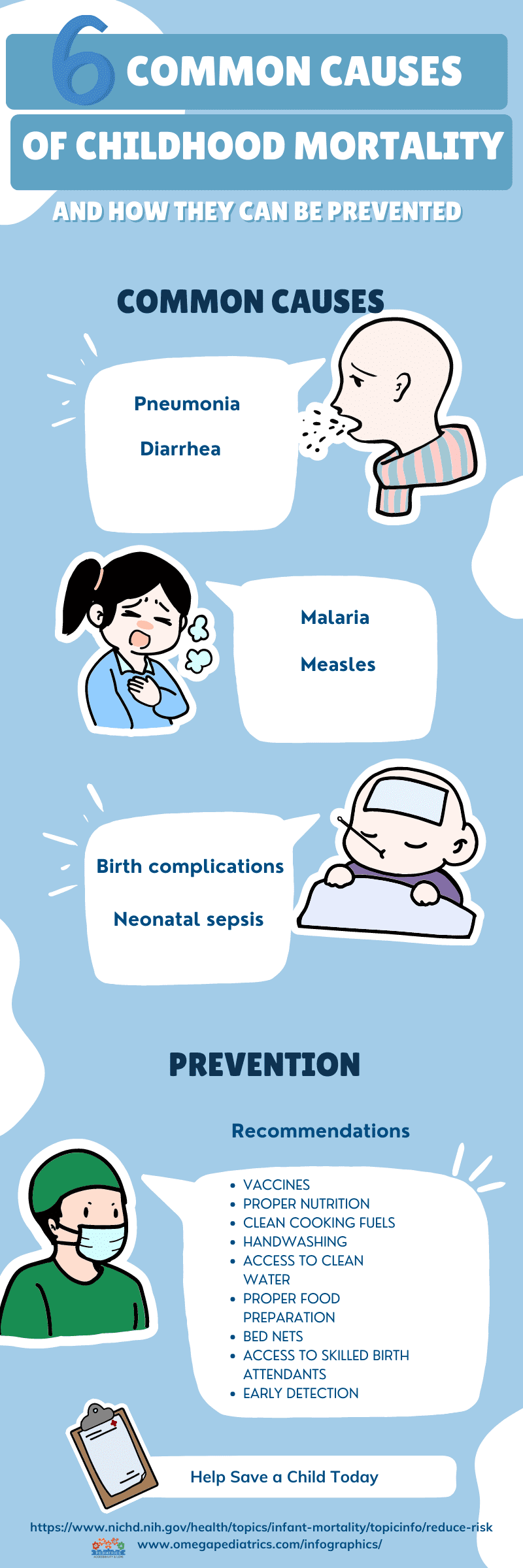Table of Contents
Childhood mortality remains a global concern, with millions of children dying each year from preventable causes. By addressing these common causes and implementing preventive measures, we can significantly reduce childhood mortality rates. Here are the six common causes and strategies for prevention:

Pneumonia:
Pneumonia is a leading cause of childhood mortality, particularly in low-income countries. Prevention strategies include:
– Vaccines: Immunization against common pathogens that cause pneumonia, such as Streptococcus pneumoniae and Haemophilus influenzae type b (Hib), can significantly reduce the risk of pneumonia.
– Proper nutrition: Ensuring children receive adequate nutrition, including exclusive breastfeeding for the first six months of life, helps strengthen their immune system and reduces the risk of pneumonia.
– Clean cooking fuels: Promoting the use of clean cooking fuels, such as liquefied petroleum gas (LPG) or electric stoves, reduces indoor air pollution and the risk of respiratory infections, including pneumonia.
Diarrhea:
Diarrheal diseases are a major cause of childhood mortality, primarily in developing countries. Prevention strategies include:
– Handwashing: Encouraging frequent and proper handwashing with soap and clean water significantly reduces the transmission of diarrheal pathogens.
– Access to clean water: Ensuring access to safe and clean drinking water helps prevent waterborne diseases, including diarrheal infections.
– Proper food preparation: Promoting safe and hygienic food handling practices, such as cooking food thoroughly and avoiding cross-contamination, helps prevent diarrheal infections caused by contaminated food.
Malaria:
Malaria is a life-threatening disease transmitted through the bites of infected mosquitoes. Prevention strategies include:
– Bed nets: Sleeping under insecticide-treated bed nets reduces the risk of mosquito bites and protects against malaria infection, especially for children and pregnant women.
– Indoor residual spraying: Applying insecticides to the walls and surfaces of homes helps kill mosquitoes and prevent malaria transmission.
Measles:
Measles is a highly contagious viral infection that can lead to severe complications and even death. Prevention strategies include:
– Vaccines: Immunization with the measles vaccine is crucial for preventing measles and its associated complications.
– Catch-up campaigns: Conducting supplementary immunization campaigns to reach children who missed routine measles vaccination can help control outbreaks and prevent measles-related deaths.
Birth complications:
Birth complications contribute significantly to neonatal and infant mortality. Prevention strategies include:
– Access to skilled birth attendants: Ensuring women have access to skilled healthcare professionals during childbirth reduces the risk of birth complications and improves neonatal outcomes.
– Early detection: Regular prenatal check-ups and early detection of potential complications during pregnancy can help healthcare providers intervene and provide appropriate care.
Neonatal sepsis:
Neonatal sepsis is a severe infection that affects newborns and can lead to mortality if not promptly treated. Prevention strategies include:
– Clean delivery practices: Ensuring that births are conducted in a clean and sterile environment reduces the risk of neonatal sepsis.
– Antibiotic prophylaxis: Administering antibiotics to high-risk newborns, such as those born to mothers with infection or premature infants, can help prevent neonatal sepsis.
By implementing these preventive measures and improving access to essential healthcare services, we can make significant progress in reducing childhood mortality rates. Collaboration among governments, healthcare providers, communities, and international organizations is vital to ensuring the successful implementation of preventive strategies and ultimately saving the lives of millions of children worldwide.
FAQ
What are the common causes of childhood mortality, and how can they be prevented?
Common causes include pneumonia, diarrhea, malaria, measles, birth complications, and neonatal sepsis. Prevention strategies vary but may include vaccines, proper nutrition, handwashing, access to clean water, bed nets, skilled birth attendants, and antibiotic prophylaxis.
How can pneumonia-related childhood mortality be prevented?
Prevention strategies for pneumonia include immunization with vaccines targeting common pathogens, ensuring proper nutrition, and promoting the use of clean cooking fuels to reduce indoor air pollution and respiratory infections.
What measures can be taken to prevent diarrhea-related childhood mortality?
Handwashing with soap and clean water, access to safe drinking water, and practicing safe food preparation techniques are effective in preventing diarrheal diseases caused by contaminated water and food.
What preventive strategies can help reduce malaria-related childhood mortality?
Sleeping under insecticide-treated bed nets and indoor residual spraying are effective in preventing malaria transmission by reducing mosquito bites and killing mosquitoes in the home environment.
How can measles-related childhood mortality be minimized?
Immunization with the measles vaccine and conducting catch-up campaigns to reach children who missed routine vaccination are essential for preventing measles outbreaks and associated complications, ultimately reducing mortality rates.



